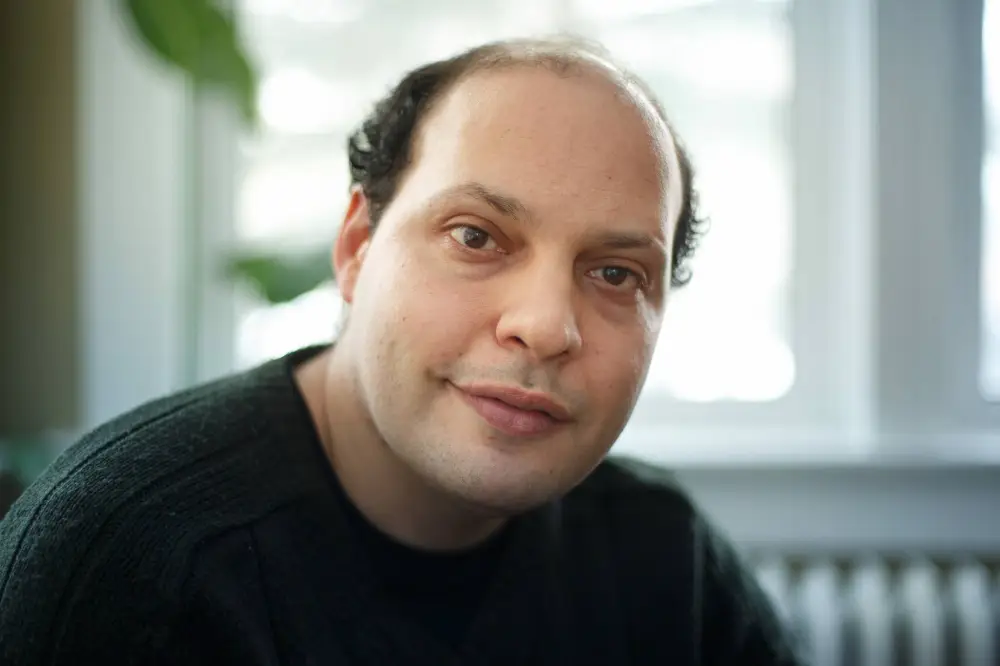Local News
Four seniors’ apartment buildings connected to the Jewish community were built in a 20-year period in Winnipeg

Three have had open and fair admission policies throughout their histories, but now there are questions about how Shalom Gardens accepts new applicants
By BERNIE BELLAN There have been several periods in the history of Winnipeg’s Jewish community that saw bursts of construction activity of different sorts.
Perhaps the most notable period was the post-war era following World War II when, in no particular order, the community saw the building within a ten-year period of: the Shaarey Zedek, Rosh Pina, Adas Yeshurun (and Herzlia Academy), and Talmud Torah synagogues, along with the YMHA on Hargrave, Talmud Torah and I.L. Peretz schools, Joseph Wolinsky Collegiate, and Ramah Hebrew School.
The population of the Jewish community was growing rapidly in the 1950s and 1960s and the infrastructure that was built then was intended to serve a community that had shifted primarily from the old north end to newer communities in West Kildonan, Garden City, and River Heights.
As our community aged, however, there was another spurt of activity beginning with the construction of HSBA Gardens on Sinclair in 1970. This time, the focus was on seniors’ housing. There was a total of four buildings constructed from 1970 to 1991: HSBA Gardens, built in 1971 (50 suites); Beit Am (adjoining the Bnay Abraham Synagogue), built in the 1980s (65 suites); Shalom Gardens (next to Temple Shalom), built in 1987 (47 suites); and the Rosh Pina Housing Co-op, built in 1991 (62 suites).
Although one of the prime motivating factors in building the three north end buildings was to provide low-cost housing for Jewish seniors, over time the number of Jewish occupants of any of the three north end buildings dwindled.
As Myron Love noted in an article he wrote for this paper in 2013 upon the occasion of Temple Shalom’s 25th anniversary, “The purpose of three synagogue-related seniors apartments – the Beit Am was built adjacent to and connected with the former Bnay Abraham Synagogue and the Rosh Pina Co-op just across the road from the current Congregation Etz Chayim (which used to be the Rosh Pina) – was to provide affordable apartments for Jewish seniors who were looking to downsize and, it was hoped, to help boost attendance for Shabbat and daily minyan services at the synagogues.
“As things turned out however, with more members of the community choosing to move south – lured in part by newer assisted independent living complexes such as the Shaftesbury, the Portsmouth and the Boulton, the number of Jewish residents of the three apartment blocks is far outnumbered by non-Jewish seniors. The number of Jewish residents currently living at the 40-suite (all bachelor suites) HSBA Gardens, for example, may have dwindled to as few as one.”
And, while the construction of HSBA Gardens preceded the actual construction of the Beth Israel Synagogue on Sinclair Street, both the Beit Am and Rosh Pina Housing Co-op were built on vacant lots next to their respective synagogues.
The opening of the Rosh PIna Housing Co-op in 1991 followed the opening of Shalom Gardens in the south end in 1987. The rules governing housing co-ops in Manitoba are fairly clear:
“Co-op members purchase equity shares in the co-op and collectively become owners of the building and property.”
Members of co-ops have certain other responsibilities, as outlined in information available on a Manitoba Government website:
“1. You purchase a membership to live in a home owned by the co-op.
“2. As a member, you share in the financial and decision-making responsibility for the operation of the co-op, including who lives there.
“3. You pay a share of the costs to maintain the co-op.
“4. You build equity if you live in an equity co-op. You do not build equity if you live in a non-profit co-op.”
I spoke with Len Podheiser, who was one of the key figures involved in building the Rosh Pina Housing Co-op, and asked him how that project was financed. Len said that the financing “came 100% from CMHC (Canada Mortgage and Housing Corporation.”
“It was built at no cost to the synagogue,” Len added. There were some advantages to having an apartment block next to the synagogue, he explained, such as being able to share snow clearing and landscaping costs.
Something else that Len noted was that Saul Simkin, who was one of the leading members of the Rosh Pina at the time, owned a brick factory in Denver, and he donated the interlocking bricks that make up the co-op’s façade.
Although, according to the co-op’s current manager, there are still some Jewish residents there, it’s a far cry from 1991, when the Rosh Pina Housing Co-op first opened and, according to Len Podheiser, “it was all Jewish.”
Each of the three north end buildings is now managed by professional building management companies. Anyone who would like to live in one of those buildings can simply contact the manager of each of the buildings and, if there is an opening and they meet the criteria for living in a particular residence, they will either be accepted or they will be put on a wait list until there is an opening.
As it turns out, however, the situation with Shalom Gardens insofar as being accepted as a member of that co-op is apparently quite different.
The story behind Shalom Gardens is a particularly fascinating one.
As Myron Love noted in that 2013 article which was written upon the occasion of Temple Shalom’s 25th anniversary, the construction of Shalom Gardens was what, in fact, led to Temple Shalom being able to move into what had previously been a Baptist Church on the corner of Grant and Wilton in Winnipeg’s south end.
“In June, 1987, the 80 members/member families of Temple Shalom, Winnipeg’s only Reform Congregation, literally took a leap of faith when they approved a proposal to buy a new building and property at the corner of Grant and Wilton,” Myron wrote.
“ ‘We started with $30,000,’ recalls Lorne Sharfe, one of the driving forces behind the purchase of the new building. ‘We had to come up with $460,000 by September. Just the down payment was $10,000.’
“A committee led by Sharfe, Allan Sourkes and the late Phil Schachter beat the bushes for the remaining funds. The TD Bank was prepared to loan the congregation $350,000. The fundraising committee also acquired grants from the provincial government and the Jewish Foundation of Manitoba. Along with some funds contributed by members and proceeds from the sale of their existing building, they were able to come up with enough money to buy the property.
“The final piece though was the construction of Shalom Gardens Housing Co-op Ltd., a low income seniors co-op adjoining the new Temple.
“Sharfe spoke about the challenges of raising funds for the congregation’s new building and how the idea for the housing co-op came about. ‘We had a parking lot on the corner beside our building, he recalled. ‘We were considering different options for developing the lot and generating income for the Temple.’
“The idea for the housing co-op originated with architect and Temple member Harry Haid. The benefits of building the apartment complex were a lump sum initial rental payment of $175, 000 (which went to paying down the TD mortgage) and the opportunity to further enhance the Temple – with an expanded entrance, new carpeting, wall paneling and lighting, the installation of an elevator and air conditioning, construction of an office, cloakroom, handicap access washroom, additional storage and an elevated parking structure at the rear of the building.”
In a recent conversation that I had with Lorne Sharfe, he told me that, in fact, he had put up a personal guarantee for the $460,000 that was required to buy the church on Grant and Wilton. Unlike the three north end projects, therefore, the building of Shalom Gardens was an absolute prerequisite for the Temple Shalom congregation to undertake; otherwise there wouldn’t have been a new home for the congregation.
And, although Shalom Gardens has always been open to residents of any faith or nationality, at the very beginning it had a heavy Jewish component, just as all the three north end residences had initially.
What got me interested in the four residences that were all built either by Jewish congregations or, as was the case with HBSA Gardens – the Hebrew Sick Benefit Association, was something that I discovered about how Shalom Gardens treats applicants for membership in that co-op.
While Shalom Gardens does have a part-time manager, unlike the Rosh Pina Housing Co-op, which is managed day-to-day by a professional apartment management firm, the members of Shalom Gardens actually play an active role in the day-to-day management of their building and it is one individual member of that co-op who seems to have the power to decide who will move into the co-op, whether or not a particular applicant may have applied ahead of another applicant.
Here is how I became involved in trying to sort out a troubling situation in which an individual was first told there was a vacancy at Shalom Gardens by the manager of Shalom Gardens, but when she immediately sent in her application, it was subsequently returned to her with the news that the unit had already been rented and that she would have to go on a wait list.
As I’ve noted before, I’ve been delivering kosher Meals on Wheels every Friday for the Gwen Secter Centre. On January 21st one of my clients mentioned that she would like to move elsewhere and she wondered whether I could recommend a nice place.
I immediately suggested Shalom Gardens, as I’m very familiar with that residence and think very highly of it. My customer told me she would follow up my suggestion and contact Shalom Gardens.
Two weeks after having mentioned Shalom Gardens to this client, on February 4th she told me that she was quite upset with what had subsequently happened to her.
She told me that when she called Shalom Gardens she was told there was a vacant unit there and that, if she sent in her application with a deposit, she would be able to have that unit.
But, shortly after having sent in her application, the client told me she received a letter from the manager of the membership committee of Shalom Gardens, in which she was now informed that the unit in question had been given to someone else. She wondered what had happened in the interim period?
I told her that I would attempt to ascertain exactly what happened, i.e. Why was she told there was a vacant unit which she could have, and then told that it was not available?
I did speak to another resident of Shalom Gardens and asked that person whether they had an idea what might have happened? This person suggested that the chair of the membership committee is able to decide who moves into Shalom Gardens on her own and evidently she had not wanted to see the vacant unit rented out to my Meals on Wheels client.
I have attempted to contact the manager of the membership committee to find out why she rejected my customer’s application, but I was told that she’s in Vancouver now and I was unable to reach her. I have also attempted to contact the manager of Shalom Gardens who, I presume, is the person to whom my customer spoke when she inquired about any vacancies at Shalom Gardens to ask her what happened, but she did not return my calls.
While I can well understand that Shalom Gardens was not built with the specific purpose of providing housing for Jewish seniors – unlike the three north end buildings, I am somewhat dismayed at the sequence of events that led my Meals on Wheels client first to get her hopes up, then to have them dashed. While the members of Shalom Gardens themselves have ultimate responsibility for managing their co-op, it seems evident that one individual who vets applications for membership wields inordinate power in deciding who will be accepted as a member. It was suggested to me that this individual has favoured friends of hers when it comes to moving into what is a very highly sought after seniors residence in the south end, and that individuals such as my Meals on Wheels client have been bumped as a result.
Unfortunately, it seems, there is no recourse for this individual, except to have me put in print what happened to her, which might lead to a much closer scrutiny on the part of Shalom Gardens co-op members how the chair of the membership committee handles applications for membership in that co-op.
Really, what ought to happen is that applications for membership at Shalom Gardens should be handled by someone who has no particular interest in favouring anyone over anyone else.
Local News
New Israeli restaurant opens in River Heights

By BERNIE BELLAN (July 6, 2025) It’s been a long time since our community has been able to welcome the opening of a restaurant that specializes in Israeli food.
That void is now going to be filled with the opening of The Green Falafel, at 1833 Grant (corner of Centennial – next to the Subway).

The restaurant is the fulfillment of a dream long held by the husband and wife team of Ariel and Eden Maudi, who have been living in Winnipeg the past 11 years.
Ariel, who was born in Israel and grew up in Beer Sheva, says that he worked in telecommunications in Ramat Gan for several years. He adds though that he had always dreamed of owning his own falafel stand in Israel, but life was difficult there and he decided to come to Canada as a tourist to see whether there were any opportunities here for him, Eden and their two young children.
Eden, who was born in Russia and moved to Israel with her family in 1996, stayed behind with the two kids, who were both pre-schoolers, while Ariel tested the waters in Canada first.
Ariel says he came to Canada as a tourist in 2013. His first stop was in Toronto, where he acquired his 1st class driver’s license. At the end of 2013 he moved to Winnipeg where he began working as a truck driver. Soon he found himself employed as a successful sales person at Vickar Nissan where, he says, he once achieved the status as the top car sales person in Canada. After working at Vickar Nissan for a number of years, Ariel began working as an installer for Bell MTS.
Meanwhile, Eden began working at a Walmart, later at the Costco on Regent.
But, when the opportunity to move into a space that had been previously occupied by another restaurant, but which had closed, became available, Ariel and Eden decided to open their own Israeli restaurant in an area that hadn’t seen Israeli food served since the controversial closure of Bermax Café in 2019.
The Maudis say that they will be serving a variety of Israeli dishes – all vegetarian, and that they will be fully kosher.
The “green” in Green Falafel, by the way, Ariel Maudi explains, comes from the cilantro and parsley that are added to the chickpeas. In addition, their pitas will be coming from Israel and will be baked fresh daily.
The Green Falafel will be open from 10-8 daily. Delivery will be available through Uber Eats and DoorDash.
Call 204-557-7837 for information.
Local News
Previews of shows with Jewish performers at this year’s Fringe Festival July 16-27

For show dates and venues go to winnipegfringe.com
By BERNIE BELLAN As has been our custom for many years now we try to find shows that have either Jewish performers or themes that would have particular appeal for Jewish audiences. Many of the Jewish performers at this year’s festival have been here before, but several are new. In no particular order here are blurbs about the shows we’ve found that fit the criteria I’ve just described. (By they way, if we’ve omitted a show that should be included in our list there’s plenty of time to get added to this post. Just drop me a line at jewishp@mymts.net.)

You’ve Been Served: A One-Woman Show About Divorce, Cults, and Coming of Age at Midlife
Noemi Zeigler
You are hereby summoned… to laugh, cry, and maybe belt out a Streisand number in solidarity. You’ve Been Served is a raw and riotous solo comedy by writer-performer Noemi Zeigler. It all begins when Noemi is served divorce papers on top of a garbage bin lid while taking out the trash—an undignified start to a full-blown midlife unraveling.
At 50, still clinging to her dream of becoming a singer, she falls under the spell of a music producer slash self-help guru, joins a spiritual cult, and, instead of landing a record deal, she lands in jail. Behind bars, with help from her long-buried inner child, she begins to reclaim her voice and her power. Turns out, dreams really do come true—just not the way she expected.
The show features vividly drawn characters—including a manipulative cult leader, a toxic ex-husband, and a jail guard named Roach who shares Noemi’s obsession with the fashion of Charlie’s Angels (the ‘70s TV version, of course.)
With salsa dancing, twerking, and a belting rendition of Don’t Rain on My Parade, Zeigler dives into abandonment, reinvention, and self-rescue. As she confronts perimenopause, she discovers it’s not the end—it’s the new puberty. The show touches on grief, sexuality, and spiritual confusion, but Noemi’s childlike optimism asks: What if your breakdown is actually your breakthrough?

You’re good for nothing… I’ll milk the cow myself
Written & Performed by Natacha Ruck
France, 1981: The first socialist president is about to be elected and young Natacha is ready to implement her own political platform. But first, she has to take down the schoolyard bully,emasculate the rules of French grammar and make off with grandmother’s chocolate.
If you think you know the limits of Jewish mothers, evil grandmothers and transcontinental lovers, meet Natacha Ruck’s family. This true tale of three generations of women, facing three world wars, is equal parts hilarious, shocking and zany.

A One Human Being, Potentially Comedic Performance of Beauty and the Beast NEW WORK!
Written & Performed by Alli Perlov
Be our guest! Local high school drama teacher Alli Perlov is back for a tale as old as time. Can she sing? Not really. Can she act? That’s debatable. Will you laugh? Oh… probably.
Perlov plays dozens of characters, some human, some animal, and many objects, in a comedic exploration of Beauty and the Beast.
In an homage to this brilliant musical adventure, through witty commentary and unstoppable energy, Perlov aims to entertain an audience that isn’t forced to be there like her students.

Hockey Sticks and Beaver Pie
Written & Performed by Melanie Gall
Take a trip around Manitoba. From the 30,000 ft. St. Adolphe snow maze to the Narcisse snake dens! After all, where else holds both the title of Slurpee Capital of the World and the Guinness Record for the most people simultaneously howling like wolves?
Deanna Durbin, Terry Jacks and Burton Cummings are among the many homegrown stars, and Hockey Sticks features their music along with original songs and the stories that make this province unique.
Starring Melanie Gall from past shows Piaf & Brel, Ingenue and Toast to Prohibition

Nerohilarity Exposed
Produced by Adam Schwartz
We all sometimes feel exposed, whether that’s as a fraud or a pretender.
The performers of the award-winning Neurohilarity show, Danielle Kayahara (Laugh Out Loud CBC), Carole Cunningham (Yuk Yuks, The Debaters), Adam Schwartz (Winnipeg Fringe) and Rollin Penner (Yuk Yuks, CBC, Rumors, Winnipeg Comedy Festival), apply a comedic spin to the experiences that make us feel insecure, stripping away the emotional weight with nittygritty jokes and stories that will have you laughing uproariously.
Brilliantly awkward.

A Lesbian in the Kitchen
Willow Rosenberg
Professional lesbian Willow Rosenberg takes you on a journey through the centuries, superstitions and tablespoons of her lifelong passion for baking in this spiritual successor to 2024’s Jenny Award-nominated A Lesbian in a Bear Store.
Whether you have a favourite spatula, bake once or twice a year, or live in constant fear of being told to “just fold it in”, this one-woman show about family, joy, tradition (but make it gay),
Judaism, comfort, home (but make it gayer*), love, chemistry and magic is for you!
*Who’re we kidding, it’s all gay!

Eleanor’s Story: An American Girl in Hitler’s Germany
Written & Performed by Ingrid Garner
(Ed. note: Although Ingrid Garner isn’t Jewish, we thought the theme of this show might have a special appeal for Jewish readers.)
Based on Eleanor Ramrath Garner’s best-selling memoir, this 16x internationally award-winning adaptation – performed by her granddaughter, Ingrid Garner – details Eleanor’s youth as an American caught in Second World War Berlin.
Punctuated with humour and accompanied by cinematic sound and video, Garner embodies her ancestors in this coming-of-age odyssey, delivering an account of war that is more relevant than ever.

Reviewing The Free Press 2
Benji Rothman
The Winnipeg Free Press has run amok, reviewing each and every Fringe show over the past two decades without consequence or recourse. Now, it’s their turn… again.
In this refurbished work that debuted at last year’s Winnipeg Fringe, Benji Rothman once again takes the Winnipeg Free Press to task. In this (mostly) new, (hopefully) hilarious 45-minute show, Rothman dives deep into their past and exposes their faulty journalism, imbalanced reporting and, of course, embarrassing typos.
Local News
Jewish performers at this year’s Winnipeg Folk Festival July 10-13

The Black Sea Station
Long ago, there were the klezmorim, itinerant musicians who roamed the back streets of Eastern Europe, playing at parties for meals and a few coins. The sound they honed then was a visceral exploration of life’s joy, and its loss; they could whip audiences into a frenzy of dancing, or bring them to tears with the mournful wail of a clarinet. Today, Winnipeg’s own The Black Sea Station is carrying on this tradition. Featuring Daniel Koulack (bass), Victor Schultz (violin) and Myron Schultz (clarinet) — cofounders of seminal local klezmer act Finjan — along with Moldovan accordion wizard Nikolai Prisacar and multi-instrumentalist Ben Mink, the quintet transports listeners to a time and place long past. Through a mix of original songs rooted in history, and traditional tunes spun up with modern zest, they whirl through the exuberant klezmer sounds of their Eastern European heritage, tending the old ways with deep love and respect.
The Black Sea Station will be performing Sunday, July 13, at 1:00 pm in Snowberry Field.

Romi Mayes
Romi Mayes has taken some hard knocks in her life, but she’s never faded away. For more than 25 years, Manitoba’s first lady of blues-rock has been a lynchpin of the Canadian roots scene. She earned that position the old-fashioned way, through her gritty, passionately emotive music. With her sizzling guitars and full-throated rasp, the Juno-nominated performer howls and purrs through razor-edged lyrics, rocking out wherever she can find a stage. She’s long been one of the hardest-working musicians on the circuit, keeping a busy slate of gigs and mentoring up-and-coming artists to get a foothold on the trails she blazed. Now, after a nine-year hiatus from the studio, Mayes has put her scintillating sound back on record with her long-awaited seventh album, Small Victories — a return that leaves no doubt, no matter the ups and downs, Mayes is here to stay.
Romi will be performing Friday, July 11, at 1:00 pm in Burr Oak.

Leonard Podolak (with Matt Gordon)
Ireland’s Matt Gordon is a fiddler and singer, whose fleet-footed clogging and thigh-slapping hambone has taken stages by storm since the 1980s. Leonard Podolak is a virtuosic master of the clawhammer banjo, who for decades has whipped up some of Manitoba’s wildest roots parties with his band, The Duhks. Put those talents together, and they can promise you this much: we’re all gonna have a real good time. Longtime friends and musical collaborators, Gordon and Podolak deliver an exhilarating trip through old-time Appalachian music. Their performances seamlessly blend intricate instrumental lines with heartfelt singing and dazzling dance. They’ve teamed up on a few records over the years, including 2020’s bigband extravaganza Power Wagon: Live At Shanley’s. But the best way to experience this duo’s toe-tapping, hand-clapping chemistry is to see it live.
Podolak and Gordon will be performing A concert with a side of clogging Sunday, July 13, at 3:00 pm in Folk School.
